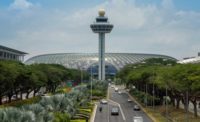Moshe Safdie Designs Golden Dream Bay in Qinhuangdao, China
























Architects & Firms
After 40 years of building libraries, museums and government buildings around the world, Moshe Safdie may still be best known for Habitat 67, his experimental “town” of stacked housing units in Montreal. Now Safdie is building a much larger version of Habitat in Qinhuangdao in Hebei Province. The ambitious project is expected to open in 2014. The developer, Kerry Properties, is “already driving piles while we complete the design,” the architect reports.
The project grew out of preparation for a museum show — a retrospective of Safdie’s career that opened last year at the National Gallery of Canada.Donald Albrecht, the curator of the show, suggested that it end with an examination of Habitat. So Safdie asked participants in a fellowship program in his Boston office to take a fresh look at the 40-year-old project. Their brief: How has Habitat lived up to its promise? How might it be made more affordable, more sustainable, or made more adaptable to current urban conditions, including increased density?
The team, led by Lorenzo Mattii, produced five updated versions of Habitat for the museum show and gave them names like Undulating Membrane Habitat (for a huge building that appears to billow like a curtain) and Urban Window Habitat (for a configuration in which condo units frame large rectangular openings.)
At about the same time, Safdie says, he was approached by Kerry Properties, one of the largest developers in China, which, he says, “is really interested in exploring novel ideas for housing.” Kerry executives asked Safdie to be part of an invited competition for Qinhuangdao, a resort community 200 miles east of Beijing, on the Bohai Sea.
"Normally, we are suspicious of developer-sponsored competitions,” says Safdie. “But they were very keen on experimenting, so we took a chance.” Safdie’s team took what they considered the most buildable of the Habitat of the Future schemes, the Urban Window, and adapted it to Kerry’s waterfront site, at a size of more than 186,000 square meters. The units, which average about 95 square meters, are designed to serve both full- and part-time residents.
The Montreal Habitat has 158 units; the new project, called Qinhuangdao Golden Dream Bay, will have 15 times that many. The change of scale meant sacrificing some of the virtues of the original Habitat. About 45 percent of the units will have roof gardens“open to the sky,” while in Montreal, all units have such roof gardens.In Qinhuangdao, 45 percent of the units will have furnishable balconies; and some units will have no private outdoor space. But all will enjoy views of elevated parks and swimming pools, which Safdie believes will create both a resort-like character and a sense of community. The arrangement of units helped the project meet China’s daylighting standards, which require that every unit get at least three hours of direct sunlight, even at the winter solstice. Safdie says his firm had to use CAD to demonstrate the project’s compliance to Chinese authorities.
The complex will be like nothing else in Qinhuangdao, which is crowded with conventional housing blocks. It resembles Safdie’s Marina Bay Sands hotel complex in Singapore, with its vast rooftop park, as well as Steven Holl’s Linked Hybrid, in Beijing, and Arquitectonica’s seminal Atlantis condo building in Miami, Florida, which grabbed attention in the 1980s with a five-story “window” punched through its center. But here, the windows will be more than 20 stories tall. Says Safdie, “The local authorities liked it because it doesn’t block the views from other developments facing the sea.”



